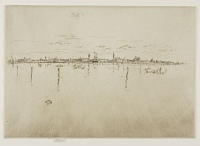KEYWORD
belltower, cathedral, church, gondola, lagoon, palace, panorama, riva, sailing ship, seascape.
TITLE
The only question is whether the title starts with 'The' or not, for example:
'
The Little Venice' (1880, F.A.S.)
2
Possibly '
The Lido, Venice' (1882, New York Etching Club).
3
Little Venice' (1883, F.A.S.)
4
'
The Little Venice' (1886,
Frederick Wedmore (1844-1921)).
5
The original title, and that accepted by most later cataloguers, is definitely '
The Little Venice'.
DESCRIPTION
A panoramic view of Venice, beyond the still lagoon, under a cloudy sky. There is a two-masted ship by the distant quayside, in the centre, and four gondolas on the lagoon, threading their way through the network of poles that indicate the waterways.
SITE

Venice from the Lido, 2006.
Photograph © M.F. MacDonald, Whistler Etchings Project.
It is a view of Venice from the Lido, taken from the Riviera Santa Maria Elisabetta near the church of that name. It is similar to the view in a pastel, Blue and silver - The lslands, Venice
[m0822]. From left to right, the view includes the Public Gardens, Santi Giovanni e Paolo, San Giorgio dei Greci, San Zaccaria, the campanile and domes of San Marco, the tower of San Giorgio, then, just visible in the distance, the Redentore, the Zitelle, the domes of Santa Maria della Salute, and the Giudecca. This view drawn accurately on the copper plate, is reversed, as usual, in the print; thus, the Public Gardens appear at far right and the Giudecca at far left in the print. 6
According to T. R. Way: '[Whistler] had done it from one of the islands, to which there are excursions by steamboat, allowing an hour or two on shore before returning. ' 7 The Lido was in fact quite near Venice and served by regular ferries, so Whistler could spend a lot longer than 'an hour or two' on shore, and return at will.
It is possible that it was exhibited in New York in 1882 as 'The Lido, Venice', but this has not been confirmed. 8
DISCUSSION
'I recollect two other prints in which the artistic motive is much the same as in the present one; they are the View of Montrose, by Sir George Reid, in the 'Life of Paul Chalmers,' and the View of Amsterdam, by Rembrandt, - and Little Venice is the finest of the three.' 9
Although, none of his contemporaries ever recorded Whistler using any drawing aid, Grieve suggests that Whistler used an optical device to ensure accuracy:
'The accuracy of his draughtsmanship shows him ... to have been a topographical artist of genius. His remarkably keen eye, possibly aided by an optical device such as a camera obscura, and his skilled hand, enabled him to record exactly what was before him.' 10
However, many an artist and any topographical draughtsman (trained as Whistler was at the U.S. Military Academy at West Point) could equal this accuracy without resorting to optical aids. Grieve goes on to qualify his suggestion, saying:
'probably more important for [Whistler] was the rhythm he imposed on the scene ... the positioning of the horizontal line of buildings on the rectangular page, the placing of the gondolas, marker posts and his butterfly on the expanse of the lagoon, were matters of artistic judgement and Whistler's judgement was supreme.' 11

